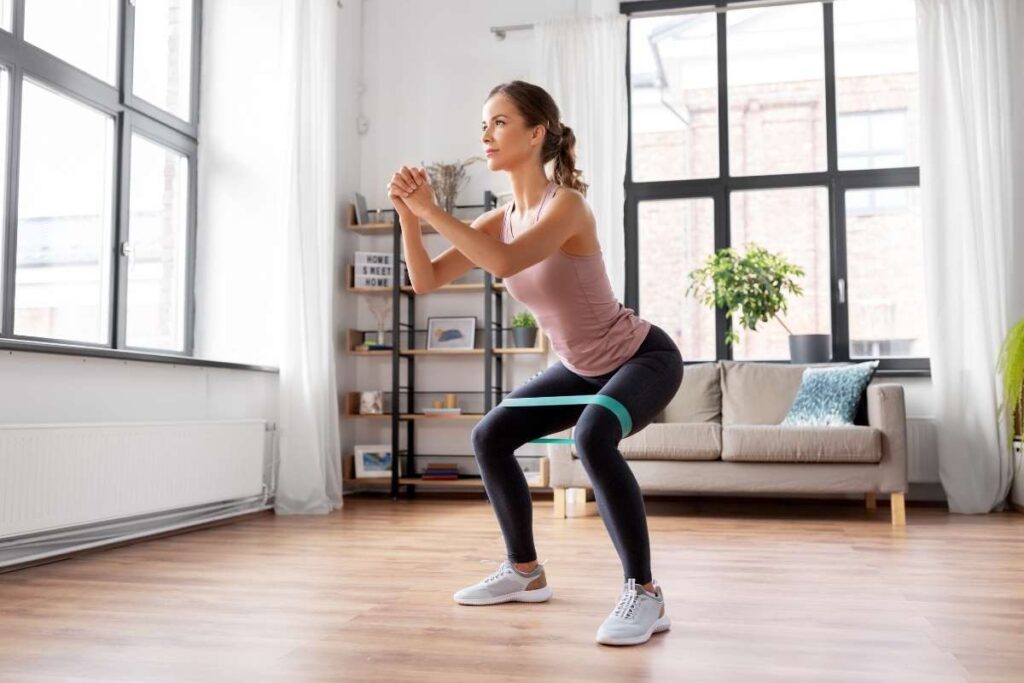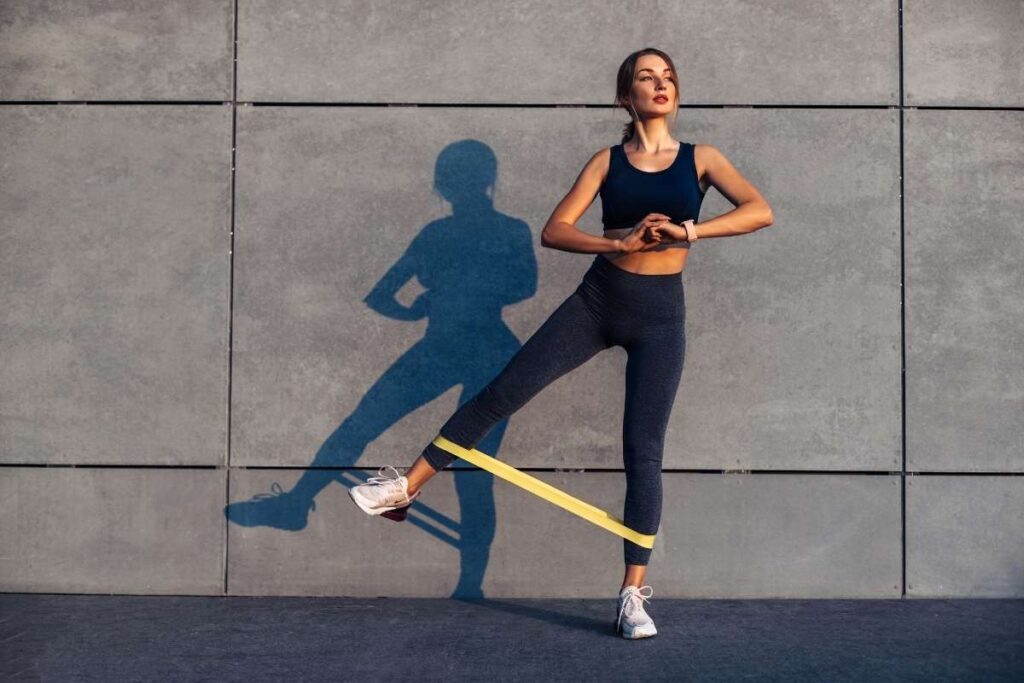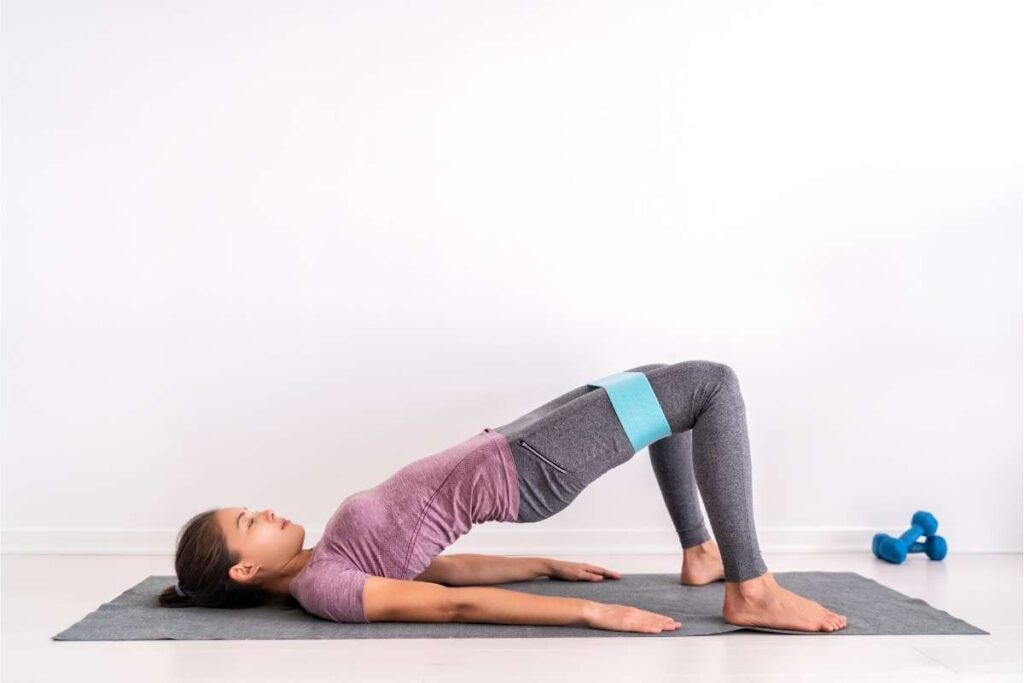This post may contain affiliate links at no additional cost to you. As an Amazon Associate I earn from qualifying purchases. Click to view our full disclosure.
What's inside
Ready to learn some thigh exercises with resistance bands?
Resistance bands are amazing for allowing you to work out wherever you want to and still get whole-body resistance.
It’s common to want to change the shape and tone of the thighs. Fortunately, these exercises will help whether you want to gain muscle or lose fat – or both.
When you do a resistance band workout for thighs, you can challenge muscles like the quads, hamstrings, and adductors. Working these muscles makes thighs stronger and more aesthetic.
Not sure it’ll work for you? I’ve been a personal trainer for many years, and I have seen numerous clients only use resistance bands to achieve their goals. That’s how I know you certainly can, too!
Keep reading to learn more about using resistance bands and discover your favorite thigh exercise with resistance bands!
What do thigh bands do?

When you wear bands around your thighs, the muscles have to work harder during the exercise because of the resistance.
Thigh exercises without bands can be effective, too. But eventually, you will need to implement the use of bands for progressive overload to ensure you are still making progress.
Do resistance bands slim thighs?

Because of the calories burned during thigh exercises with resistance bands, fat loss on your thighs is undoubtedly possible.
However, while you can target your thighs for muscle growth, you cannot target them for “slimming” or fat loss.
It is up to your genetics where stored fat burns first on your body. Your thighs may be the first area, but they also may be the last!
Who are thigh resistance band exercises for?

Anyone. Resistance bands are safe and straightforward to use.
But if you desire to gain strength in your lower body while slimming down your thighs, then thigh resistance band exercises are for you especially!
These movements are also great for being included in general full-body workouts or HIIT routines.
How to Use a Resistance Band for Thighs
Related: How To Gain Weight In Buttocks And Thighs?

While it depends on the exercise, the resistance band is most often positioned right above the knee of both legs.
With certain movements, it makes more sense for it to be below the knee.
The most critical aspect of thigh workouts with bands is that the resistance band is not placed directly on the knee because this can lead to injury.
What are the best resistance bands to use in your thigh workout routine?
Related: 15 Best Leg Workouts With Dumbbells

When picking the best thigh workout bands, there are two factors to consider.
The first is that it needs to be a loop. While resistance bands with handles are extremely useful for working other muscles of the body, you need loop bands for your resistance band exercises for thighs.
The second thing to pay attention to is the material the band is made from. The cheaper rubber bands are not ideal because they often fold and roll up the leg during an exercise.
Try and find loop bands made of fabric if you can.
Need more advice? I share some of my favorite loop resistance bands in my article on using resistance bands for shoulders.
Benefits of Using Resistance Bands in Your Thigh Workout Program
Related: 12 Week Resistance Band Training Program

Doing any general thigh exercise will be beneficial for shaping your lower body.
However, your results will start to plateau if resistance isn’t increased gradually over time through progressive overload.
This is where resistance bands come in! Bands challenge the muscles in your thighs to work harder than they had to with bodyweight only.
You will continue to grow stronger and leaner legs if you properly implement thigh toning exercises with resistance bands into your routine.
Resistance bands are also great because of how portable they are. You can literally fit them into most purses, and they can be taken with you on vacation so you can still get your workouts in no matter where you are!
15 Best Thigh Exercises With Resistance Bands
Related: 10 Inner Thigh Exercises
1. Abductions
Abductions are great for working your glutes and contributing to a slim and toned lower body! Aim to do the general abduction movement once or twice a week on your leg days.
Equipment Requirements
Loop band
How-To Perform Abductions
- Take a seat on a bench or chair with the loop band positioned above your knees.
- Tense up your abdominals before you pull your knees away from each other against the resistance of the band.
- Pause here for a moment before bringing your knees back together.
Benefits
- Works your glutes
- Stabilizes your hips
Pro Tips
- You can try leaning forward a bit if you want the movement to target your glutes extra.
- Try to do a pulse at the top of the exercise to make it more difficult.
2. Adductions
Adductions involve the opposite movement as abductions and are amazing for targeting the inner thighs.
The adductors are often neglected, so be sure to do this exercise at least once a week.
Equipment Requirements
Loop band
How-To Perform Adductions
- Place one end of the loop right above the ankle of one of your legs and have the other end attached to a stationary object.
- Be in a standing position with your feet slightly wider than hip-width.
- Pull the leg with the band toward your other leg.
- Pause for a moment before releasing.
Benefits
- Works the adductors
- Aids with supporting explosive movements
Pro Tips
- If needed, feel free to hold onto something for balance.
- Be careful not to use too much resistance initially, as this can lead to injury of a generally underworked muscle.
3. Banded Jump Squats
Related: 10 Best Outer Quad Exercises
Jump squats on their own are difficult, but have you tried them with a resistance band? Adding a band ensures that this intense exercise challenges the muscles in your thighs even more!
Equipment Requirements
Loop band
How-To Perform Banded Jump Squats
- Place a band right above your knees and start in a standing position with your feet hip-width apart.
- Bring your arms forward as you push your glutes back and come down into a squat.
- Once your thighs are parallel to the floor, throw your arms back and push up through the balls of your feet to come off the ground.
- Land softly back into the squat position and repeat.
Benefits
- Works the quads
- Challenges the hamstrings
Pro Tips
- Focus on pushing your legs a bit outward to feel extra resistance from the band during this movement.
- Ensure you land softly on your feet when you come back down from the jump to prevent jarring your knee and hip joints.
4. Clamshells
The clamshell is a great exercise for all levels that works the glutes and outer areas of the quads. Include these in a leg day workout!
Equipment Requirements
Loop band
How-To Perform Clamshells
- Place the loop above your knees and lie down on your side with your legs stacked and knees bent at a 45-degree angle.
- Keeping your feet touching, slowly lift the top knee off of the bottom as high as you can.
- Pause at the top of the movement before releasing it back down to the starting position.
Benefits
- Works the quads
- Challenges the glutes
Pro Tips
- Add a pulse at the top to make this exercise more difficult.
- You can try counting to three on the way up and down to increase the challenge.
5. Deadlifts
The deadlift is an essential compound movement that should be included in nearly everyone’s workout program, no matter their goals.
This exercise targets multiple muscle groups and helps with everyday functional tasks.
Equipment Requirements
Loop band
How-To Perform Deadlifts
- Place your feet hip-width apart on the center of the band and grab the other side with both hands.
- Push your glutes back, keep your back straight, and push your shoulders back. You should have a naturally slight bend in the knees.
- Pull on the band and straighten your legs out as you come up to a standing position.
- Pause here before bending your knees and slowly lowering the band back down to your feet.
Benefits
- Trains the entirety of the lower body
- Functional movement
Pro Tips
- If you wish to target your hamstrings more than your quads, try a straight-leg deadlift instead.
- Focus on not arching your lower back throughout the movement as this can lead to severe injury.
6. Diagonal Band Walk
The diagonal band walk is a great exercise that can be included during your workout or used as an activation method beforehand. This movement works the glutes and provides resistance to the thighs.
Equipment Requirements
Loop band
How-To Perform Diagonal Band Walk
- Place the band above your ankles with your feet hip-width apart and put your hands on your hips.
- Bring one foot forward in a diagonal direction, and then step your other foot forward to meet it.
- Step that foot forward in the opposite diagonal direction and bring the initial foot forward to meet it.
- Repeat this motion for a predetermined amount of steps or distance.
Benefits
- Works the lower body
- Challenges the glutes
Pro Tips
- Go through this exercise slowly to increase effectiveness.
- If this exercise begins to be too easy, try increasing the thickness of the band rather than the number of steps so you can challenge the body more in less time.
7. Donkey Kicks
Donkey kicks are a classic for working the glutes, but they also create some slight activation in the hamstrings!
These are amazing to do with the assistance of a resistance band, so include them in your next lower body routine!
Equipment Requirements
Loop band
How-To Perform Donkey Kicks
- Place a band above your knees and get onto all fours with a neutral spine and your gaze on the floor.
- Keeping your foot flexed and knee bent, bring one heel up to the sky.
- Pause at the top of the movement before returning your knee to the ground and repeating.
Benefits
- Builds the glutes
- Activates the hamstrings
Pro Tips
- Add a pulse at the top to make this exercise more challenging.
- Try to do one side for reps before the other rather than alternating legs to increase intensity.
8. Fire Hydrants
The exercise is similar to donkey kicks, except you bring your leg out instead of back. Use this movement as a finisher to challenge multiple lower body muscles.
Equipment Requirements
Loop band
How-To Perform Fire Hydrants
- Place a band above your knees and get onto all fours with a neutral spine and your gaze on the floor.
- Keeping your knee bent at a 90-degree angle, bring one leg up to the side as high as possible.
- Pause at the top before slowly bringing that leg back down.
Benefits
- Works the glutes
- Challenges the quads and hamstrings
Pro Tips
- Add a pulse at the top to increase the difficulty of this exercise.
- Count to three as you bring your leg both up and down to make it harder.
9. Glute Bridges
Want an essential yet effective thigh exercise with a resistance band that targets your core, glutes, and hamstrings? Try glute bridges during your next lower body workout!
Equipment Requirements
Loop band
How-To Perform Glute Bridges
- Lay on your back with your feet firmly planted on the floor.
- Have your arms down by your sides and a band positioned above your knees.
- Tense up your abdominals and push your hips up to the sky. Your body should form a straight line from your knees to your head.
- Hold at the top for a moment before slowly bringing your glutes down to the floor.
Benefits
- Works your glutes
- Challenges your hamstrings
Pro Tips
- Try adding a pulse at the top to make the exercise more difficult.
- If you want to maximize the band’s effectiveness, press your legs against them throughout the exercise.
10. Glute Bridge Hold with Alternating Kicks
Although the video mentioned above does not display this exercise being conducted with a band, doing so will make it even more difficult!
This exercise targets your abdominals, glutes, and hamstrings, making it a worthwhile movement.
Equipment Requirements
Loop band
How-To Perform Glute Bridge Hold with Alternating Kicks
- Lay on your back with your feet firmly planted on the floor.
- Have your arms down by your sides and a band positioned right above your knees.
- Bring your hips up to the sky into a glute bridge.
- While holding this position, bring one bent knee up toward your chest.
- Slowly bring that leg back down before lifting the other leg.
- Repeat this movement on each side for a predetermined amount of reps.
Benefits
- Works the glutes and hips
- Challenges the hamstrings
Pro Tips
- If needed, you can support your lower back with your hands to make the exercise less difficult.
- Keep your chin tucked into your chest to avoid straining your neck.
11. Lateral Band Walks:
Lateral band walks are great for toning the thighs while increasing the heart rate. Use these as a finisher for your next workout!
Equipment Requirements
Loop band
How-To Perform Lateral Band Walks
- Place a band either above your ankles or knees.
- Keeping your back straight and chest up, slightly squat down.
- Step one foot out to the side and follow with the other.
- Do this for a predetermined amount of steps before going in the other direction.
Benefits
- Stabilizes the hips and knees
- Works the glutes and quads
Pro Tips
- Try to move slowly to increase the intensity.
- The further you squat down, the more difficult the exercise will be.
12. Side Plank Leg Raises
Side planks are great for your abdominals, but how can they work your lower body? You are about to find out with these challenging side plank leg raises!
Equipment Requirements
Loop band
How-To Perform Side Plank Leg Raises
- Lay on your side with your legs fully extended and stacked and your forearm flat on the floor.
- Place your hand on your hip and lift your hips off the ground. Your body should form a straight line.
- Hold this position as you slowly raise your top leg up and then lower it to meet your other leg.
- Do this for a predetermined amount of reps before releasing your hip back onto the floor.
Benefits
- Builds core strength
- Works your glutes and quads
Pro Tips
- An easier version of this exercise would be to keep your knees bent rather than straight.
- You can also try doing this exercise on a straight arm if that is more comfortable than being on your elbow.
13. Squats
Related: Do Squats Work Abs?
In addition to deadlifts, squats are an essential compound movement that helps with everyday tasks. They are amazing for working the lower body, especially when you add resistance.
Equipment Requirements
Loop band
How-To Perform Squats
- Place a band right above your knees and position your feet hip-width apart.
- Keep your back straight and shoulders back as you push your glutes back and bend your knees.
- Come down into a squat and pause when your thighs are parallel to the floor.
- Push back up through your heels to come to standing.
Benefits
- Challenges the quads
- Works the glutes and hamstrings
Pro Tips
- Try pushing your legs out and against the band as you come down for maximum results.
- Don’t let your knees go past your toes to help prevent injury.
14. Standing Glute Kickbacks
Standing glute kickbacks are amazing for growing your glutes, but they also activate your hamstrings to help tone your thighs! Include these in your next lower body workout.
Equipment Requirements
Loop band
How-To Perform Standing Glute Kickbacks
- Position a band above your knees and hold onto something for help with balance.
- Keeping your leg straight with only a slight bend in the knee, slowly bring your leg back behind you as far as you can.
- Gradually return your leg to the starting position before repeating.
Benefits
- Works the glutes
- Activates the hamstrings
Pro Tips
- Focus on contracting the glutes for the entirety of the movement.
- Try counting to three as you bring your leg back to the starting position to make it more difficult.
15. Standing Hip Flexion
This hip flexion exercise is a unique movement in that it primarily targets the area of the hips. Use this exercise at the beginning of your workouts to help you warm up the lower body.
Equipment Requirements
Loop band
How-To Perform Standing Hip Flexion
- Place each foot in the ends of the loop so that the band is centered on the balls of the feet.
- Position your hands on a wall and lean your weight into it.
- Slowly bend one knee and lift your foot up against the resistance of the band until your thigh is parallel to the floor.
- Lower your foot back down before repeating on the other side.
Benefits
- Loosens up the hips
- Works the quads
Pro Tips
- Keep your foot flexed throughout the movement to keep the band properly positioned.
- Count to three as you bring your foot up to make the movement harder.
Thigh Resistance Band Workout Program
Related: Knees Over Toes Program
Beginner
- Monday: Workout #1
- Tuesday: Rest day
- Wednesday: Rest day
- Thursday: Workout #2
- Friday: Rest day
- Saturday: Rest day
- Sunday: Rest day
Workout #1
| EXERCISE | SETS | REPS | REST |
| Squats | 3 | 12-15 | 1 minute |
| Standing Glute Kickbacks | 3 | 10-12 | 1 minute |
| Glute Bridges | 2 | 15-20 | 1 minute |
| Clamshells | 2 | 12-15 | 1 minute |
Workout #2
| EXERCISE | SETS | REPS | REST |
| Deadlifts | 3 | 12-15 | 1 minute |
| Standing Hip Flexion | 3 | 10-12 | 1 minute |
| Adductions | 2 | 10-12 | 1 minute |
| Donkey Kicks | 2 | 12-15 | 1 minute |
Advanced
- Monday: Workout #1
- Tuesday: Rest day
- Wednesday: Workout #2
- Thursday: Rest day
- Friday: Workout #3
- Saturday: Rest day
- Sunday: Rest day
Workout #1
| EXERCISE | SETS | REPS | REST |
| Squats | 4 | 12-15 | 30 seconds |
| Abductions | 3 | 10-12 | 30 seconds |
| Standing Glute Kickbacks | 3 | 10-12 | 30 seconds |
| Diagonal Band Walk | 2 | 20 steps | 30 seconds |
| Fire Hydrants | 2 | 12-15 | 30 seconds |
Workout #2
| EXERCISE | SETS | REPS | REST |
| Deadlifts | 4 | 12-15 | 30 seconds |
| Adductions | 3 | 10-12 | 30 seconds |
| Glute Bridges | 3 | 15-20 | 30 seconds |
| Standing Hip Flexion | 2 | 10-12 | 30 seconds |
| Clamshells | 2 | 12-15 | 30 seconds |
Workout #3
| EXERCISE | SETS | REPS | REST |
| Banded Jump Squats | 4 | 8-10 | 30 seconds |
| Donkey Kicks | 3 | 12-15 | 30 seconds |
| Glute Bridge Hold With Alternating Kicks | 3 | 10-12 | 30 seconds |
| Lateral Band Walks | 2 | 20 steps | 30 seconds |
| Side Plank Leg Raises | 2 | 10-12 | 30 seconds |
Tips for Training Your Thighs Using Resistance Bands

1. Eat Plenty of Protein
Related: 25 Protein Boosters
To get optimal results from your resistance band thigh workouts, you need to properly fuel your muscles.
Aim to consume one gram of protein per pound you weigh. This amount effectively helps shape your lower body and improve strength and endurance!
2. Eat the Proper Amount of Calories
If you’re looking to add muscle mass to your thighs, you need to eat in a caloric surplus to provide your body with ample fuel.
If you wish to burn stored body fat on your thighs, then you would eat in a caloric deficit. Fat will burn when the body needs energy but cannot source it from calories.
To figure out how many calories you should be eating, determine what your maintenance calories are, and then add or subtract 250 to 500 calories.
3. Stay Hydrated
Drinking enough water daily will help you stay hydrated for any inner and outer thigh workout with bands you do!
Try to drink a gallon a day to help maintain a healthy water weight and optimize overall body function.
4. Prioritize Recovery
When you do any inner thigh exercises with resistance bands or outer thigh exercises with resistance bands, micro-tears are formed in the muscles. These tears can only be repaired if the body is allowed time to rest.
So, it’s essential that you get at least seven hours of sleep every night, stretch before and after workouts, and take at least one day off a week from exercising.
5. Stay Consistent
Whether you aim to gain muscle or lose fat on your thighs, you will not see the results you desire unless you are consistent with resistance band exercises for thighs.
Before you get started on working toward this goal, take a moment to assess how many days a week you can realistically commit to exercising.
Doing this will prevent you from feeling overwhelmed later on and giving up!
Conclusion
We hope that you enjoyed our guide to the best resistance band exercises for thighs!
It can sometimes be difficult to know exactly how to change. But you can follow along with our example workouts to make your own transformation!
In combination with a regular workout routine, be sure to also eat plenty of protein, stay within your calorie restrictions, drink a gallon of water daily, and give your body enough time to rest to see the best results.
Please comment below your favorite thigh exercise with resistance bands, and don’t forget to share this article with anyone else who would find it helpful!
Frequently Asked Questions
Do resistance bands work for thighs?
Thigh exercises with bands are certainly an effective way to target the muscles of the thighs because the bands provide resistance that leads to muscle growth.
Resistance bands are also great because they can be used at home or in the gym!
Are resistance bands good for losing thigh fat?
While you cannot target fat on your thighs with resistance bands or any other exercise tool, you would eventually burn thigh fat if you kept up with your thigh band exercises.
It is up to genetics as to where you both gain and lose fat first in a caloric deficit.
How do I tone my upper thighs with resistance bands?
To work on the upper thigh area, try performing standing hip flexions, banded jump squats, and diagonal band walks that target the hip area and quadriceps.
What leg exercises can you do with a resistance band?
Honestly, you can do almost every leg exercise with a resistance band as long as your movement isn’t too restricted by having it positioned around both legs.
Bring along a resistance band to your next lower body workout!

